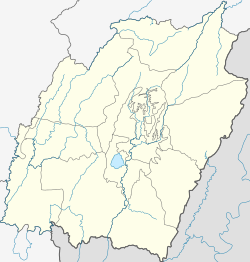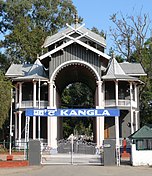From top, left to right: the sacred images of God Pakhangba and his consort, the Kangla Sanathong, the holy Hiyang Hirens inside the Hijagang, the Pakhangba Temple, Kangla, the statue of Meidingu Nara Singh, the Sanggai Yumpham and the dual statues of Kanglā Shā dragon, the emblem of Manipur | |
 | |
 | |
| Alternative name |
|
|---|---|
| Location | Imphal West district |
| Region | Kangleipak (Meitei for 'Manipur') |
| Coordinates | 24°48′29″N 93°56′24″E / 24.808°N 93.940°E |
| Type | capital city (historical) |
| Part of |
|
| History | |
| Periods | Classical Antiquity |
| Cultures | Meitei culture |
| Associated with | |
| Events | Anglo Manipur War |
| Site notes | |
| Condition | protected |
| Ownership | |
| Management | Kangla Fort Board |
| Public access | yes |
| Architecture | |
| Architectural styles | Meitei architecture |
| Kingdom of Manipur | ||||||||||||||||||||||||||||||||||||||||||
|---|---|---|---|---|---|---|---|---|---|---|---|---|---|---|---|---|---|---|---|---|---|---|---|---|---|---|---|---|---|---|---|---|---|---|---|---|---|---|---|---|---|---|
| Part of History of Manipur | ||||||||||||||||||||||||||||||||||||||||||
| Kings of Manipur | ||||||||||||||||||||||||||||||||||||||||||
|
||||||||||||||||||||||||||||||||||||||||||
| Manipur monarchy data | ||||||||||||||||||||||||||||||||||||||||||
|
||||||||||||||||||||||||||||||||||||||||||
The Kangla with diacritic Kanglā,[1] officially known as the Kangla Fort,[2] is an old fortified palace at Imphal, in the Manipur state of India.[3][4][5] It was formerly situated on both sides (western and eastern) of the bank of the Imphal River, now remaining only on the western side in ruined conditions. Kangla means "the prominent part of the dry land" in old Meetei.[6] It was the traditional seat of the past Meetei rulers of Manipur.[7][8]

Kangla (Imphal) was the ancient capital of pre-modern Manipur.[9] The Kangla is a revered spot for the people of Manipur, reminding them of the days of their independence. It is a sacred place to the Meiteis.[10]
The Kangla is being proposed to be declared as a UNESCO World Heritage Site, for which there are discussions ongoing in the Indian Parliament.[11][12]
- ^ Sharma, H. Surmangol (2006). "Learners' Manipuri-English dictionary.Kangla". dsal.uchicago.edu. Retrieved 28 July 2022.
- ^ Deshpande, Abhijeet (19 December 2017). Backpacking North East India: A Curious Journey. Notion Press. p. 98. ISBN 978-1-946556-80-6.
- ^ Sajnani, Manohar (2001). Encyclopaedia of Tourism Resources in India. Gyan Publishing House. p. 226. ISBN 978-81-7835-017-2.
- ^ James, Rajesh; Venkatesan, Sathyaraj (1 July 2021). India Retold: Dialogues with Independent Documentary Filmmakers in India. Bloomsbury Publishing USA. p. 232. ISBN 978-1-5013-5269-0.
- ^ Prakash, Col Ved (2007). Encyclopaedia of North-East India. Atlantic Publishers & Dist. p. 1600. ISBN 978-81-269-0706-9.
- ^ Sanajaoba, Naorem (1988). Manipur, Past and Present: The Heritage and Ordeals of a Civilization. Mittal Publications. p. 415. ISBN 978-81-7099-853-2.
- ^ Chandra, N. D. R.; Das, Nigamananda (2007). Ecology, Myth, and Mystery: Contemporary Poetry in English from Northeast India. Sarup & Sons. p. 82. ISBN 978-81-7625-742-8.
- ^ Binodini (17 March 2015). The Maharaja's Household: A Daughter's Memories of Her Father. Zubaan. p. 203. ISBN 978-93-84757-19-9.
- ^ Chandra, N. D. R.; Das, Nigamananda (2007). Ecology, Myth, and Mystery: Contemporary Poetry in English from Northeast India. Sarup & Sons. p. 82. ISBN 978-81-7625-742-8.
- ^ Dhar, Pannalal (1998). Ethnic Unrest in India and Her Neighbours: Also Includes Europe, West Asia, the Balkans and Africa. Deep & Deep Publications. p. 115. ISBN 978-81-7100-818-6.
- ^ "Manipur titular king moves Parliament to declare Kangla Fort as World Heritage Site". The Times of India. 5 February 2021. ISSN 0971-8257. Retrieved 8 February 2023.
- ^ "Kangla as a World Heritage Site". Imphal Free Press. Retrieved 8 February 2023.






